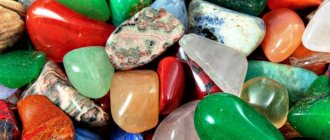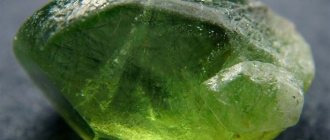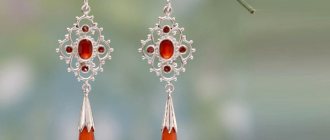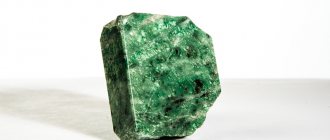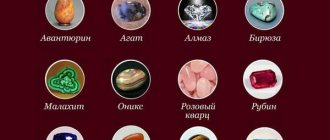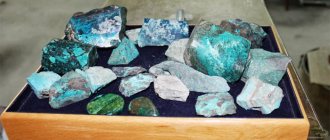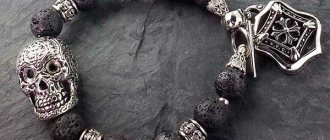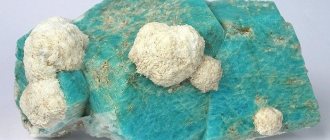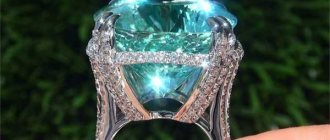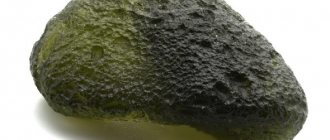History and origin
Stones in the form of granular aggregates or rather large prismatic pillar crystals were first found in the southern part of sunny Spain and Andalusia and then described in 1798 by a geologist and mineralogist from France, Delameterrier.
The stone immediately attracted attention; it changed color depending on the lighting. This phenomenon is called pleochroism. The stone was in great demand by the Knights of Malta and Catholic monks due to another feature - when cut, a bright cross appeared inside it. Therefore, andalusite is often called the “Maltese cross” or cross stone.
Place of Birth
In addition to Spanish deposits known since the 18th century, deposits of the mineral are found all over the world. It is of metamorphic origin, so it is typically found in argillaceous, micaceous, metamorphic schists, secondary quartzites and pegmatites. Mining is carried out in mountainous areas; shallow deposits of andalusite are located on the banks of mountain rivers.
Andalusite is a fairly common mineral that occurs in the form of columnar, granular, thick tabular or columnar formations. Often during the growth process it takes the form of columnar, prismatic crystals.
One of the largest samples is considered to be a single crystal found in California, which was 61 cm long and 15 cm wide.
Large reserves have been discovered in the following regions:
- Spain - deposits are gradually depleted;
- Brazil and Sri Lanka are known for green and olive andalusites;
- The Elbrus region is famous for the good quality of the mined crystals;
- Russia - deposits are found in the Urals, Kabardino-Balkaria, and also in Transbaikalia;
- Canada, USA, Austria, Czech Republic, Turkey produce industrial raw materials.
Physical properties
| Property | Description |
| Formula | Al2SiO5 |
| Hardness | 7,5 |
| Density | 3.12—3.18 g/cm³ |
| Refractive index | 1,641—1,648 |
| Kink | Uneven, fragile |
| singonia | Rhombic |
| Cleavage | Imperfect |
| Shine | Glass |
| Transparency | Transparent |
| Color | Grey, yellow, brown, golden, orange-brown, pink, red, dark green or colorless |
The ability of the mineral to absorb rays heterogeneously, changing color, makes the stone exceptional - two colors can appear in one stone, creating the effect of diachronism (optical two-color). Even in constant light, the stone can shimmer with gray - violet, olive - green, pink - brown shades, which are caused by aluminum, iron, chromium and manganese that are part of it. The stone can be colorless (but this is very rare), transparent or translucent.
Classification
Andalusite in its structure has two types of aluminum atoms - in coordination 6 and 5. Non-ideal octahedra (octahedrons) consisting of a compound of aluminum and oxygen are parallel to the axis in the form of chains that are connected along the edges. Covalent bonding exceeds ionic bonding.
| IMA (International Mineralogical Association) status | Authorized, "Grandfathered" described before 1959 |
| Nickel-Struntz classification 10th edition (pending revision) | 9.AF.10 |
| Dana Classification 8th Edition - Primary Groups | 52.2.2b.152: Neosilicates precipitated by SiO4 groups and O,OH,F,H2O |
| Hey,s CIM Ref | 15.1 |
Crystallography
| Syngony (crystal type) | Rhombic (pseudo-tetragonal) |
| Class (HM) | mmm (2/m2/m2/m) – irregular pyramid |
| Space group | Pnnm |
| Unit cell volume | A=7.798(7) Å, b=7.9031(10) Å |
| Ratio | a:b:c: = 0.987:1:0.703 |
| Unit cell | V:342.44 Å3 |
| Duality | rare |
| Morphology (elements) | The elements are crystals and columnar compounds having almost square sections, usually elongated in parallel (up to 20 cm). Crystals may be interrupted due to interference with external minerals. |
Chemical composition
Anadalusite is a prismatic anhydrous crystal that is highly resistant to acids.
| Formula | Al2(SiO4)O |
| Formula (MMA - International Mineralogical Association) | Al2SiO5 |
Physical properties
Andalusite is considered a pure mineral that is common in clayey and coal-shale. Occasionally it is found in mica schists.
Transparent green andalusite is considered its most valuable form. Unlike other pleochraean gemstones, where gem cutters try to reduce the multi-colored tones and emphasize the best color, cutting andalusite instead tries to produce a good combination of colors.
| Shine | Vitreous, sub-vitreous, bold |
| Transparency | Transparent |
| Color | Pink, dark red, white, gray, green, yellow, sometimes purple |
| Mohs hardness | 6 ½ — 7 ½ |
| Series | white |
| Density | |
| Split | Excellent/good |
| Fracture | Irregular Subconchoidal |
| Density | 3.13 – 3.21 cm3 (according to measurement results), 3.149 g/cm3 (according to calculation results) |
| Perseverance | brittle |
Production (fields)
Mineral deposits are often not deep, on the mountain slopes of rivers. Since the discovery and description of the mineral, a large number of deposits have appeared in different countries of the world.
Findings of gem-quality crystals are quite rare. In addition to good examples still being mined in Spain, the Minas Geras and Espirito Santo placers in Brazil are considered promising deposits. Interest in them continues after the discovery of a very large and pure crystal weighing 75-100 carats, from which an excellent piece of jewelry was made.
Unique dark blue crystals have already been found in placers in India, Burma and Ceylon.
The most famous andalusite deposits are in the USA (California, Maine, Connecticut and New Mexico), Canada (Quebec), Australia and Russia (Nerchinsk).
Not long ago, crystals of excellent quality up to 20 cm in length were discovered in Uzbekistan.
Green veridite crystals are mined in Sweden, Spain, Austria and China. There have also been several finds of blue andalusite crystals in Belgium.
One of the famous andalusites is kept in Washington at the Smithsonian Museum. This is a brown crystal, weighing 28.3 carats, brought from Brazil.
Industrial mining of andalusite for the production of refractory materials exists in Italy, Germany, Sri Lanka and Brazil.
Featured in the Smithsonian's current public exhibition - Andalusite with quartz, muscovite and biotite.
Varieties of mineral
Andalusite is presented in three types:
- Chiastolite, or “cross stone,” is formed as a result of the combination of a mineral with clay and coal, and has a brownish-green tint. It is distinguished by the presence of a pattern on the surface that resembles a cross.
- Titanic andalusite is distinguished by the presence of titanium oxide in its composition, which gives the mineral a gray color, which sometimes shimmers with silver shades.
- Viridin is a mineral with a high content of iron and manganese inclusions, used in jewelry. In cross-section, the crystal has a greenish, “grassy” tint with light green (less often yellow) inclusions.
TYPES AND COLORS OF ANDALUSITE
Among the andalusites suitable for jewelry processing, the following types of stone are distinguished:
| chiastolite |
|
| viridin (manganandalusite) |
|
Green andalusite
Few crystals suitable for jewelry processing are found; It is difficult to cut a stone.
Medicinal properties
For hundreds of years, healers have used andalusite in their practice. A talisman made from this stone, worn on the chest, is one of the best preventive and therapeutic agents for diseases of the respiratory system: bronchi, trachea, lungs. It is good especially for children and elderly people who do not want to be treated with antibiotics.
But the medicinal properties of the cross are not limited to this. It is known that the stone has a wonderful effect on the human psyche and nervous system: it calms, restores inner harmony, and helps to survive stress and shock.
And souvenir products from the “Maltese cross”, located within the walls of the house, increase the body’s resistance to disease and improve the functioning of the heart and blood vessels.
Therapeutic effect
The healing properties of andalusite help solve physical and emotional problems:
- Joints. The mineral helps retain calcium in the body. Relieves or alleviates pain from arthritis, gout, arthrosis, rheumatism.
- Heart, blood vessels . The ability of andalusite to simulate the work of the heart and blood vessels and normalize intracranial pressure has been revealed. It helps with migraines.
- Emotions. Andalusite is an ally in overcoming depression, experiencing stress, and maintaining the mood of those on a diet.
Uncut, primordial crystals are more powerful as healing agents.
The mineral heals the respiratory system (beads), increases overall tone, strengthens the immune system, especially during serious illnesses or after surgery. For this, as well as for weight loss, wear rings or pendants.
Magical powers
The stone has truly magical properties that were noticed back in the Middle Ages. Its strength is not inferior to the most expensive gems. Sorcerers use the cross to communicate with the other world, summon spirits and put them into a state of trance, meditation, and predict the future.
REFERENCE! It is known for sure that Nostradamus himself never parted with an andalusite amulet.
In magical circles, the cross is called the “Seeing Stone” - it helps to form the correct opinion about both a person and an event of the past or future.
The stone helps people with paranormal abilities to penetrate the secrets of the Universe, gain sacred knowledge, and reach a new level of spirituality.
The magical properties of andalusite
Psychics believe that andalusite can open portals to other worlds and establish connections with the souls of the departed.
Andalusite is a unique stone. It is simultaneously popular among both psychics and opponents of magic - clergy.
The latter is due to the fact that one of the varieties of the mineral, chiastolite, has a cross-shaped pattern. Correlating this cross, created by nature itself, with Christ, representatives of the clergy began to use the stone in their paraphernalia. Andalusite was used to make rosaries or personal amulets to help resist the attacks of evil.
It is known that a brown mineral with a black cross pattern was popular during the time of the Templars. Members of the knightly order believed that this was their lucky talisman, helping them gain secret knowledge and bring light to the dark masses. In addition, the pattern on the stone resembles the Templar cross.
People who practice magic appreciated the gem for other interesting qualities. It is believed that the gem has the ability to open portals to other worlds and is able to establish connections with the souls of the departed. This was the reason that fortune tellers and clairvoyants began to use andalusite in their practices.
Such a talisman will also benefit the ordinary person:
- will help you touch unknown secrets;
- will ward off the evil eye, damage;
- will protect against attacks from entities from the subtle world.
The amulet protects not only its owner, but also his home. With such a protector, you can not be afraid of uninvited guests with evil thoughts, thieves and even fires.
The meaning of the stone for a person
Andalusite has enormous energy, perhaps due to its natural cross, which is capable of maintaining the integrity of the owner’s aura. The stone should be used by extroverts - people whose line of work is related to people and is aimed at providing assistance.
These are doctors, rescuers, priests, military (but in peacetime, soldiers are not recommended to wear a talisman ). The special influence of the cross on those who are associated with plants and animals is noted: gardeners, field farmers, veterinarians.
Interesting Facts
There are incredible facts that andalusite is associated with, among them the following stand out:
- the gem will never help individuals with bad thoughts who wish harm to others;
- the stone improves a person’s health, gives him effective protection against magical effects and influences;
- Nostradamus wore an amulet with a gem.
Today it is believed that the talisman gives success to those individuals who strive to understand the mysteries and secrets of the Universe and know how to communicate with parallel worlds and otherworldly forces.
Compatibility with other stones
Since andalusite has great energy, it cannot be used in jewelry, talismans, or amulets together with precious stones that have the same energy (diamonds, rubies). Otherwise, jewelry will lose not only its beauty, but also its ability to positively influence a person. They will become useless.
This stone, thanks to its unusual beauty and magical power, is destined to be the center of any decoration. Therefore, there must be weaker minerals around it, capable of subordinating their strength to the Maltese cross. They can be Lapis Lazuli, Carnelian and Peridot.
STONE PROPERTIES AND APPLICATION
- Andalusite is good for melancholic, phlegmatic, and sanguine people.
- For the work of the crystal in magic and lithotherapy, the days of the first quarter of the moon and the 4th and 5th days of the full moon are especially recommended.
- For those who are passionate about yoga, it is recommended to meditate on the stone before solving any problem.
- Chakra - Vishuddha.
The magical properties of andalusite
- The cross could not help but interest the clergy.
- Rosaries, rings, and crosses are made from stone.
- Esotericists appreciated the beauty and magical properties of the gem. It is believed that it facilitates communication with intangible entities, with the spirits of the departed.
- The crystal helps in communicating with the natural world, which includes humans, animals, and plants.
- Uncut stones help keep a cool head in stressful situations.
- Andalusite protects against the evil eye and damage. While in the house, it will protect the home from accidents, thieves, and unwanted guests.
Chiastolite
They believe that the stone will only help for noble purposes.
Andalusite does not accept those seeking enrichment and personal gain.
Andalusite in lithotherapy
According to lithotherapists, crystals are used in the treatment of:
- diseases of the lungs and respiratory system;
- circulatory system, blood vessels;
- immune system;
- hypertension;
- insomnia;
- stress, depression.
We recommend: LIAPIS-LAZURITE: properties, types, application
Contraindicated in diabetes mellitus and lupus erythematosus.
Compatibility with Zodiac and names
Andalusite is friendly and refuses to help anyone. The main thing is that the person is not aggressive or angry. The crystal will try to get away from such an owner - it will simply get lost.
Andalusite's favorite zodiac signs are Libra and Gemini.
Suitable for people with names that begin with “A”, “G”, “K”. Especially suitable for Andrey and Christina.
Jewelry with mineral
The mineral is processed differently depending on its color, transparency and cross-shaped pattern, which is why the jewelry is made differently.
- If a cross is observed in the stone, then it is not cut, but only polished, creating cabochons (translated from French as “heads”). They are widely used in massive men's rings, amulets, and as a central stone in necklaces.
- Very rare transparent andalusites are cut - such stones are beautiful in rings and earrings.
- Round, oval and teardrop-shaped stone cuts are most common, but such jewelry has a fairly high price - $15-25 per carat (the smallest cut andalusite is at least 5 carats).
- High-quality pink-green and pleochroic andalusites from Brazil are highly prized, starting at $250 per carat.
You can buy jewelry with the Maltese cross in jewelry stores and on the Internet.
A faceted stone without a frame costs from 800 to 2,750 rubles, earrings with a cross inside the stone - from 2,700 to 5,000 rubles, bracelets - from 5,600 rubles, pendants and rings (depending on the size of the stone) - from 2,500 rubles. You can also find beads on sale, but the stones in them are often small and the cost is quite high.
History of the mineral
The stone has been known for thousands of years under different names:
- “Alexandrite of the poor” - due to its visual similarity to the stone of the first row;
- Lapis Lucifer – “Lucifer’s stone”; based on the biblical story about the fall of a fallen angel to Earth;
- “fairy cross” - according to legend, the tears of fairies mourning Jesus fell on the stones, becoming crosses;
- cross - that’s what Europeans of the Middle Ages called it.
The history of the official name is also interesting. The first scientific mention of andalusite dates back to the middle of the 18th century. But the Spaniard Torrubia considered it a type of chryostolite, and not an independent mineral. The description of the gem is the merit of the German classifier geologist Abraham Gottlieb.
Scientists also made a mistake with the location of the deposit: it was not Andalusia, but its “neighbor” Castile. However, the name “andalusite” was retained and has been considered official since the beginning of the 19th century.
How to distinguish from a fake?
The authenticity of a stone is determined based on its features:
- The ability to change color (pleochroism) is tested simply: you need to rotate the stone, and, regardless of the lighting, the color of the stone will change.
- Knowing that andalusite is a very hard mineral, you can run it across the glass. The scratch will remain on the glass - the surface of the cross will be intact.
- Features of the internal pattern also make it possible to determine the authenticity of the stone. A careful examination with a magnifying glass in a real stone will reveal a symmetrical pattern with a transition from dark brown stripes to lighter ones.
Types of andalusite
The following varieties are distinguished for andalusite:
- Chiastolits, cross stones or cross stones. This is an opaque variety of the mineral, on the cross section of which, when processed, a dark cross becomes noticeable. Its formation is explained by selective absorption by the stone faces during growth of particles of coal and clay from the accompanying rock. This feature of the stone is indicated by its name, which goes back to the Greek words “hiastos” and “lithos”, meaning “crossed” and “stone”.
- Viridin is a type of andalusite with a high content of manganese oxide. This species is characterized by a rich green-herbaceous hue.
- Titanium andalusite – as the name suggests, contains an admixture of titanium.
Caring for stone products
In modern jewelry, they offer special chemical solutions for cleaning jewelry and souvenirs made of precious stones and metals. But we must remember that stones do not tolerate even mild chemical exposure.
Andalusite is a very durable stone, but it remains a natural material. Therefore, it is better to care for it in a simple way: take the cheapest laundry soap without additives, make a soap solution and use a soft brush to clean the jewelry with light movements, then blot with a cloth or paper towel and dry.
IMPORTANT! Andalusite should not be stored in direct sunlight.
Where is andalusite used?
Depending on the aesthetic conditions and variety, the scope of andalusite application is industry or jewelry.
Jewelry
Andalusite is classified as a semi-precious stone, but ten years ago there was little interest in it. The turning point was the presentation of the jewelry, in which the main feature was a large faceted iridescent stone (under one hundred carats). The price gradually increased by almost two orders of magnitude: jewelers “discerned” the unusual color scheme and the pleochroism effect inherent in the gem.
Gold ring with andalusite
The range of jewelry with andalusite stone is varied:
- inserts of rings, brooches, cufflinks, pendants, necklaces;
- they are processed in a teardrop shape, an oval or a ball; stones that are cut randomly, that is, with maximum regard for their original shape, look interesting; everyone is unique;
- earrings with inserts with a “cross” effect are being bought up by adherents of youth subcultures (punks, goths, rockers);
- gold, silver or jewelry alloy (nickel silver) is used for the frame;
- Faceted andalusite looks advantageous next to carnelian, lapis lazuli or peridot.
It is better to wear jewelry with andalusite in bright light during the day or evening: the play of the stone will be most evident.
The cost of a carat of emerald or pink-green Brazilian stone is $300+. The price of jewelry depends on the material of the frame and the characteristics of the stone. So, a drop pendant will cost only $9–10.
Industry
Technical andalusites are used in the manufacture of the following assortment:
- refractories required by metallurgists, manufacturers of aluminum, cement, glass;
- source material for the production of foundry sand and refractory flour (used for coating steel and cast iron);
- paving stones, paving and thermal insulation tiles;
- car spark plugs;
- industrial equipment made of glass.
Finally, without andalusite, the production of ceramics, including high-grade types, is problematic.
Compatibility with zodiac signs
(“+++” – the stone fits perfectly, “+” – can be worn, “-” – is strictly contraindicated):
| Zodiac sign | Compatibility |
| Aries | + |
| Taurus | + |
| Twins | +++ |
| Cancer | + |
| a lion | + |
| Virgo | +++ |
| Scales | +++ |
| Scorpion | + |
| Sagittarius | + |
| Capricorn | + |
| Aquarius | + |
| Fish | +++ |
The natural material is associated with the constellation Virgo. It is considered to be universal in astrological terms - it can be used by all signs of the zodiac.
But most of all the stone is suitable for Libra, Gemini and Pisces. He especially protects them, strengthens their health, and brings them into a state of harmony.
There are no contraindications to the use of semi-precious stone.
Is this stone right for you?
REFERENCE! The Maltese cross is consistent with the number 7, which is the sum of two divine numbers: 3 and 4.
How to care for stone
Hardness, acid resistance and fire-resistant qualities do not negate the care of the stone.
But caring for andalusite is not difficult:
- Jewelry inserts should be protected from strong impacts, falls onto a hard surface or from a great height. Otherwise, chips will appear.
- Dirt is removed with warm water and mild detergent or soap, and dried with a soft cloth.
- It is better to do without aggressive household chemicals.
You can store jewelry in a common box. Mystically minded people believe that there should be a moonstone nearby. The union “andalusite + selenite” increases the strength of both.
Helpful information
- Due to its high heat resistance, the stone is widely used for refractory lining.
- Sand obtained after processing stone is used to produce dishes, furniture, and spark plug elements. They are absolutely safe at high temperatures.
- The stone is called "the poor man's alexandrite", but it changes color regardless of the light.
Andalusite, Maltese cross, cross, “Seeing Stone”... Whatever you call it, we are talking about an amazing mineral given to humanity as a talisman. But we must remember: he will help only those who are pure in soul and have no evil intentions.
5 / 5 ( 1 voice )
Interesting facts about andalusite:
- A talisman or amulet with andalusite is suitable for all people associated with mental activity. It is recommended to purchase it for a doctor, scientist, theologian, monk and priest. The mineral is also the patron saint of the military during battles and battles; it is not recommended to wear it during peacetime.
- Due to its pronounced pleochroism, andalusite was once often called “the poor man’s alexandrite.” Unlike the latter, turning at a different angle is enough to change the shade of andalusite, while alexandrite needs a change in lighting.
